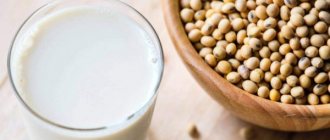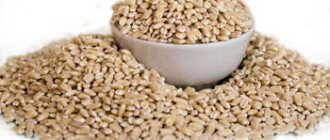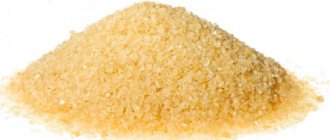Chemical composition
The composition of the product is very diverse. It contains vitamins, amino acids, macro- and microelements, and plant fiber.
Coconut milk is an exotic product obtained from the processing of palm fruit pulp.
Main components:
- Vitamins (A, group B, C, E, PP, K). Vitamins increase hemoglobin synthesis, activate regeneration processes, strengthen the body's immunity, which reduces its susceptibility to the effects of harmful microorganisms.
- Macroelements (calcium, magnesium, potassium, phosphorus, sodium). The presence of these components improves the functionality of muscle tissue, the transmission of impulses in the nervous system, and also normalizes the process of blood clotting and blood pressure levels.
- Microelements (manganese, selenium, iron, zinc, copper). Their content activates collagen synthesis, prevents the growth and further development of abnormal cells, improves air exchange at the cellular level, normalizes the functioning of the reproductive organs and is involved in the synthesis of red blood particles.
- Essential and nonessential amino acids (leucine, lysine, arginine, serine, proline, threonine, isoleucine, valine, methionine). The presence of these components helps cleanse the liver of toxins, synthesize growth hormones, enhance brain activity, improve memory and human concentration. Amino acids also increase resistance to pain and temperature changes.
- Plant fiber. This component helps normalize metabolic processes, reduces the content of bad cholesterol in the body, normalizes blood sugar levels, and maintains healthy microflora in the intestines.
- Polyunsaturated acids (Omega-3, 6, 9 group) . They help reduce the likelihood of developing cardiovascular pathologies, rheumatism and cancer.
- Fatty acids (lauric, palmitic, stearic, capric). The presence of these substances has a beneficial effect on the functioning of the digestive organs. They also strengthen the body's immunity.
Be sure to read: Hazelnuts: beneficial properties, calorie content per 100 grams
Calorie content of drinks, soups, cereals based on coconut milk
From this product you can prepare delicious drinks that will fill you with energy throughout the day:
- matcha – 120 kcal per 1 serving (volume about 470 ml);
- latte – 129 kcal per serving;
- cappuccino – 98 kcal per serving;
- coffee – 43 kcal;
- cocoa – 134 kcal.
Drinks with it are popular.
Quite often, coconut milk is used to make soups.
Their calorie content per 100 g of dish is as follows:
- vegetable soup – 36.2 kcal;
- pumpkin soup – 43.4 kcal;
- tom yum – 41.7 kcal.
If you like to have cereal for breakfast, you can add coconut milk to it.
In this case, the calorie content of 100 g of the finished product will be as follows:
- oatmeal – 131 kcal;
- buckwheat porridge – 207 g per serving (280 g);
- millet porridge – 126.1 kcal;
- rice porridge – 97 kcal;
- semolina porridge – 260 kcal per 185 g.
As you can see, coconut milk is not only a tasty, but also a healthy drink. You can use it to make tea, coffee, porridge and other dishes. In addition, it can become an assistant in treating diseases and improving the appearance of skin and hair. However, try to consume no more than 200 ml of the drink per day, and consult your doctor first in case of possible intolerance.
Calories and nutritional value
Coconut milk is considered low-calorie and quickly digestible
The drink is considered low-calorie and quickly digestible despite the fact that it contains a large amount of saturated fat.
But their peculiarity is that they are short and medium chains of fatty acids, which are not able to be deposited in the form of a subcutaneous layer of fat.
When they enter the body, they are almost instantly converted into the necessary energy for the body, so 100 ml of the drink can provide 11.5% of the required energy reserve for the day.
100 g of product contains 152-230 Kcal, depending on the stage of extraction.
The nutritional value:
| Name of substance | Content |
| Fats | 27% |
| Squirrels | 4% |
| Carbohydrates | 6% |
| Water | 67,6% |
| Ash | 0,7% |
Harm and contraindications
At the same time, like any other product, coconut milk has a fairly wide list of contraindications.
First of all, this product is exotic for the post-Soviet space. This suggests that it may cause an allergic reaction in many people.
Coconut milk is contraindicated for people with fructose intolerance, as well as for pregnant and nursing mothers. People who are prone to diarrhea should use the product with caution.
It is also worth considering the fact that the canned drink contains stabilizers, flavors, thickeners and other chemicals that can adversely affect health. That’s why, if you decide to treat yourself to coconut milk, you can prepare it yourself.
Benefits of coconut milk
Thanks to the high content of nutrients, the aging process slows down, resistance to pathogens increases and digestive function is normalized.
But other general properties can be identified:
- activates brain function;
- strengthens bone tissue;
- prevents the development of depression;
- increases the elasticity of joints;
- eliminates chronic fatigue;
- prevents the formation of a malignant tumor;
- activates metabolic processes;
- has antiviral and bactericidal effects;
- prevents the development of atherosclerosis.
Important! This drink is useful for absolutely everyone: adults and children.
For women
Regular use during pregnancy reduces the tone of the uterine muscles and eliminates cramps.
Representatives of the fair sex, when consuming it, do not have to worry about extra centimeters on the waist, since the product activates metabolic processes and promotes weight loss.
Other beneficial properties for the female body can be highlighted:
- prevents premature aging of the body;
- enhances the regeneration of skin cells, which restores its tone and promotes rapid healing of wounds;
- when applied externally, creates a protective film from the harmful effects of ultraviolet radiation;
- strengthens the hair structure, prevents the appearance of split ends;
- prevents the formation of pimples, blackheads and ulcers.
Regular use during pregnancy reduces the tone of the uterine muscles and eliminates cramps.
For men
There are a number of positive qualities that are useful for men:
- The protein contained helps build muscle mass. This is especially important for men who spend a lot of time training.
- Carbohydrates in an accessible form help quickly replenish energy expended during physical activity.
- Regular consumption helps fight infertility, improves sperm quality and improves potency.
Is it possible to use coconut milk while breastfeeding?
It is acceptable to use the product during lactation if the woman consumed the drink during pregnancy. Otherwise, it should be introduced into the mother’s diet gradually so as not to cause the development of diathesis.
Be sure to read: Macadamia: benefits and harm for women and men, calorie content, composition of the nut
Regular consumption of the drink during breastfeeding speeds up the recovery process after childbirth and minimizes the likelihood of developing depression. The product also significantly improves the quality and digestibility of breast milk and normalizes the baby’s digestive function.
Is it possible for children
The dry powder retains most of its qualities.
The calcium and iron content contributes to the full development of the child and strengthens his bone tissue.
The drink’s ability to convert vegetable fats into energy is also very important for the child’s body. This allows you to quickly replenish the energy spent on games and studies. It is recommended to introduce it into a child’s diet from 3-4 years of age.
Is coconut milk powder healthy?
Dry powder retains most of its qualities, but when purchasing, keep in mind that manufacturers add additives that prevent caking of the powder and the appearance of lumps.
This feature negatively affects quality. Therefore, natural is much healthier than dry.
This variety should also not be consumed by people suffering from autoimmune diseases.
Pulp, water plus vitamins
The liquid inside the tropical nut is water. And the milk, which has a consistency similar to sour cream, is created under production conditions: the nut pulp is crushed and mixed with the required amount of water. Here are the two main components. The pulp contains elements such as sodium, calcium: phosphorus, copper, iron, zinc, sodium, selenium, phosphorus, manganese, vitamins A, C, K, E, nicotinic acid and B vitamins, 24 amino acids, polyunsaturated Omega acids, monosaccharides, disaccharides, fatty acids and essential oils necessary to maintain the health of the body. This is a storehouse of healing substances, so no additional operations in production to enrich milk with nutritional components are required. True, cocoa, soy, and other ingredients are sometimes added to drinks to vary the taste.
The release form is different. It can be powder, liquid, condensed milk. The latter is with a lot of added sugar. Manufacturers also offer consumers a paste, which, like the powder, is diluted to form a full-fledged drink at home.
How to take for weight loss
To lose extra 4 kg in 3-5 days, you should use this product as part of your diet.
Daily diet:
| Eating | Menu |
| Breakfast | 150 ml of drink; 100 g boiled white rice |
| Lunch | 100 ml milk liquid |
| Dinner | 200 g rice porridge prepared with coconut milk |
| Afternoon snack | 1 tbsp. green tea |
| Dinner | 150 g low-fat cottage cheese; 150 ml drink |
How to choose coconut milk and store it correctly?
- If you buy coconut milk at the store, try to choose responsibly. Read the information on the label carefully. It is important that the composition contains only water and coconut. Also watch the fat content of the product.
- If you plan to drink the drink, choose low-fat types. When preparing dishes, it is advisable to choose products with a fat content of 50-60%. Give preference to small containers.
- If you hide the container of a canned drink, you can store it in the refrigerator for no more than 3 days. If the mixture becomes too thick, you can heat it in a water bath. If you prepare the drink yourself at home, you should store it for no more than 24 hours.
How to use in cosmetology for face and hair
The properties of the product are widely used in solving problems with facial skin and hair.
Regular washing reduces the likelihood of acne and pimples, and also helps restore elasticity to the epidermis and reduce fine wrinkles. To tighten the oval of the face, it is recommended to use milk in combination with the usual lotion.
To nourish the hair roots, enhance their growth, and eliminate dandruff, you should massage your head 3 times a week. The duration of the procedure is 7-10 minutes. And to eliminate the problem of unpleasant oily shine, it is necessary to apply the component to the entire length of the curls, leaving for 15-20 minutes.
How to cook simple and delicious dishes with coconut milk: popular recipes
Beetroot soup
Ingredients: 200 ml of vegetable milk, small beets, small potatoes, half a head of onion, half a stalk of celery, carrots, a couple of tomatoes, a tablespoon of vegetable oil, canned corn, a teaspoon of grated ginger, salt and pepper to taste.
How to cook:
Bake the beets in the oven, remove the peel. Boil the chopped potatoes. Sauté finely chopped carrots, onions, celery, and ginger in oil. Then add chopped tomatoes to the vegetables. A little later, five minutes before readiness, pour in the potato broth and add the potatoes. Place all cooked vegetables in a blender and grind until pureed. Place the puree in a saucepan, pour in the milk and leave on low heat for a few minutes. You need to stir the soup. Serve the finished beetroot soup with herbs.
Pancakes
Ingredients: 2 glasses of milk, 2 eggs, a tablespoon of sugar, salt on the tip of a teaspoon, half a teaspoon of soda, a glass of flour.
Instructions:
Beat eggs with sugar and salt. Pour milk into the egg mixture, then add flour, soda, stir, breaking up lumps. The dough needs to rest for 10 minutes. Heat a frying pan and bake without adding oil.
Pudding
Ingredients: a glass of tropical nut milk, half a glass of rice, a tablespoon of sugar, 15 ml of sugar syrup, apple, cinnamon - to taste.
How to cook:
Cook the rice. Peel the apple, cut it, sprinkle with cinnamon and sugar. Bake the apple in the oven and cool. Pour milk and syrup into the rice, stir and let it brew. Top the pudding with baked apple.
Cocktail
Ingredients: 2 glasses of herbal drink, 2 tablespoons of sugar, a glass of strawberries (can be replaced with other berries).
Method of preparation: Wash the berries and chop them. Beat in a blender along with milk and sugar.
Use in cooking
To nourish the hair roots, enhance their growth, and eliminate dandruff, you should massage your head 3 times a week. The
herbal component is used to prepare cocktails, smoothies and as a supplement to coffee. It is also used for making pudding, ice cream, and adding it to baked goods, main courses and side dishes to give it an unusual taste and aroma.
Cream and butter prepared from the product in combination with powdered sugar are used as cream for filling cakes, as well as for decorating cakes and various desserts.
What can you cook with coconut milk?
Coconut milk is used to make soups, hot dishes, drinks and desserts.
Tom Yum
One of the most famous dishes is Tom Yum soup with shrimp.
To prepare you will need:
- 400 ml coconut milk;
- ginger root;
- 200 gr. fresh champignons;
- 450 gr. peeled shrimp;
- two tomatoes;
- garlic clove;
- lemongrass;
- 2 tbsp. l. fish sauce;
- 1 tbsp. l. vegetable oil;
- 1 tbsp. l. Sahara;
- 1 chili pepper;
- lime juice;
- kaffir lime and other greens.
How to make coconut milk at home from coconut and shavings
If necessary, you can prepare a healthy drink yourself, which guarantees its quality and naturalness.
How to do it:
- Select a tropical nut without signs of damage.
- Cut the fruit and remove the pulp.
- Grate it on a fine grater.
- Pour water into the mixture to cover.
- Leave for 2 hours.
- Add a little vanilla and 30 ml of liquid honey to the resulting product.
- Mix thoroughly, beat with a blender at maximum speed for 30-40 seconds.
- Strain the milk through multilayer gauze.
- Leave the pulp cake for re-cooking.
Storage time in the refrigerator is 2 days.
The most popular questions about coconut milk
Where can I get coconut milk?
The easiest way is to buy it in a store. But if you wish, you can do it yourself, at home. To do this, you need to purchase ready-made coconut flakes, mix it with hot water, and then squeeze it by hand through a fine sieve or muslin cloth. The extraction can be repeated several times, but keep in mind that the fat content will decrease.
Extracted coconut milk can be used immediately or allowed to steep. Don't be surprised if it separates into two separate layers - an oily layer (cream) on top and a watery layer (whey) underneath.
Where and for how long can coconut milk be stored?
If the package has not yet been opened, milk can and even preferably be stored at room temperature - this way it will not clump or separate.
An open box should be kept in the refrigerator for no more than 3 days. If it is a tin can, be sure to pour the milk into another container (preferably glass).
Bitterness indicates that the milk has spoiled and it is better to throw it away without trying to use it for anything. Lumps and separation are not signs of deterioration in product quality.
Tip : If you stored coconut milk in the refrigerator at the store, when you get home, let it sit at room temperature and shake the package before opening. Most likely, separation can no longer be avoided, but don’t let this scare you: in an open box/can, the milk can be thoroughly mixed to achieve the correct consistency.
After opening the package, milk powder can be stored in the refrigerator for up to three months (airtightly sealed).
What can you make from coconut milk?
Coconut milk was originally a specialty of the Austronesian peoples. It is very popular in Thailand, Malaysia, Burma, the Philippines and Hawaii, as well as in many other southern countries. Their residents have been using coconut milk for a long time to prepare various dishes, including sweet desserts (puddings, jellies, ice cream) and hearty ones (soups, sauces, side dishes, meat and fish dishes).
Various curry pastes, hot chili peppers and ginger go well with coconut milk. It can become an equivalent substitute for traditional cow's milk if you need to prepare milk porridge, make baked goods, “whiten” coffee or create homemade ice cream.
One of the most popular Asian dishes prepared with coconut milk is the Thai spicy Tom Yum soup. And in the Philippines, a dessert made from coconut milk with rice is very popular.
Can you drink coconut milk from a can?
You can, but it’s better to pour it into a glass to see the consistency and color. It is also recommended to shake the milk before use to avoid separation.
Whole milk, skim milk, oat milk, coconut milk: which is healthier? Nutritionists explain
Just a few decades ago, the only thing we could top our cereal with was whole cow's milk.
Now there are many varieties of this drink: low-fat, lactose-free, soy. For people with allergic reactions, there are also plant-based alternatives to cow's milk (it's Lent, so the topic is more relevant than ever): almond, oat, coconut. SPLETNIK.RU, together with expert nutritionists, finds out which one is healthier. For a long time, health advocates insisted that the fat found in dairy products was harmful. For several decades, milk was considered enemy number one due to the fact that it is quite high in calories (one glass of milk contains about 120 kcal) and with age, lactase production in humans decreases, so it is simply not absorbed by the body. However, whole milk and no-sugar-added yoghurts are now again being hailed as healthier foods compared to their low-fat counterparts.
Back in the 1990s, the main recommendation from dietitians was to reduce fat in the diet, including the fat found in milk, explains Frances Largeman-Roth, nutrition expert and author of Eating in Color. ).
As more people choose low-fat yogurts and cottage cheese, manufacturers have begun adding heavy doses of sugar and artificial ingredients to their products to enhance their flavor. Result? One serving of seemingly “harmless” strawberry yogurt contains your daily sugar intake. Skim milk and flavored yoghurts not only don't make you feel full, but they're also high in sugar and don't have any health benefits, says Frances.
The main disadvantage of low-fat dairy products is that they are not balanced in fat and carbohydrates. It is believed that calcium is less absorbed from such products - this requires fats, which are deprived of the composition. It is better to choose milk with an average fat content of 2.5,
— says Galina Anisenya, World Class nutritionist.
Whole milk
Whole cow's milk contains about 88 percent water, five percent lactose (carbohydrates), three percent fat, three percent protein and less than one percent minerals. The composition of milk depends on the breed of the cow (for example, Holstein-Friesian or Jersey), the animal's diet and the stage of lactation. Cow's milk contains nutrients such as vitamins B, C, D, niacin and folate (folic acid) and bone-strengthening components.
Previously, milk had no alternative, but over time new types of this drink appeared. Surprisingly, full-fat dairy products can actually help you maintain a lean figure, says Largeman-Roth.
She cites a study of 18,000 middle-aged women of normal weight. They found that those who drank whole milk and ate full-fat dairy products were less likely to be overweight or obese later.
A small study published in the European Journal of Clinical Nutrition also found that daily consumption of whole milk increased HDL (or good cholesterol) levels, while daily consumption of skim milk did not.
But there is another opinion. Thus, nutritionist Cassie Bjork explains that milk has a high insulinogenic ability, which means that it increases blood sugar levels. It also causes inflammation, causing acne, eczema, rosacea and digestive disorders.
We don't need cow's milk and get the same nutrients from meat, seafood, vegetables, fruits and nuts. If you don't drink milk because of the hormones and antibiotics given to cows, it's best to buy plant-based alternatives, says expert and founder of Healthy Simple Life.
Many believe that adults over 30 years old should not drink cow's milk. Apparently it is poorly absorbed. However, Galina Anisenya is sure that age cannot serve as a criterion for deciding whether or not to drink cow's milk: Saying that the adult body does not absorb cow's milk, many give the following argument: animals feed on milk only during the feeding period after birth. Soon their diet changes, but this is how nature intended; if animals could continue to receive milk, this does not mean that they would not eat it. When choosing milk, we again rely on the individual characteristics of a person. If he has lactase deficiency (lactase is an enzyme that is needed to digest the milk sugar lactose), then drinking cow's milk can really be a problem.
If you have allergic reactions to casein, then you can switch to goat's milk, it contains casein in small quantities. It contains mostly albumin, which is smaller in structure, making it easier to digest.
Lactase deficiency can be genetically determined or acquired lactose intolerance, which can occur even against the background of severe stress. If the body begins to produce less of the necessary enzymes due to health conditions, then the person will experience discomfort when drinking milk.
You need to understand that alternative milk of plant origin is not milk in full, it only superficially resembles it in its liquid consistency and light shade. And it is recommended to use it as a replacement if there really are individual problems such as lactase deficiency. If there is no such problem, it is worth remembering that ordinary cow’s milk, for example, has the most optimal ratio of calcium and phosphorus for absorption in the body and will serve as a source of useful substances.
Lactose-free milk
Lactose-free milk has almost the same texture and nutrients as regular milk. For people with lactose intolerance, regularly drinking lactose-containing milk can cause digestive problems such as abdominal pain, bloating, diarrhea and belching. This milk tastes sweeter than regular milk. This is because of lactase, an enzyme added to lactose-free milk that breaks down lactose into two simple sugars: glucose and galactose.
There is no allergy to lactose. Intolerance happens, and it manifests itself in different ways. You may feel discomfort and notice a reaction from the gastrointestinal tract through bloating and “grumbling”, but the picture can be blurry - fatigue and irritability may be added to the unpleasant sensations. If lactase deficiency is severe, then the gastrointestinal tract will not accept the product,
- says World Class nutritionist.
If you suspect that milk is the culprit of your discomfort, you can keep a food diary and, by eliminating dairy products completely for a while, note changes in your well-being. If it improves significantly, then it is really worth removing it from the diet. And genetic testing can give you the most accurate results.
Soy milk
According to nutritionist David Friedman, soy milk was the first alternative to cow's milk to hit the market. Thanks to its nutrients, it is an excellent source of energy, protein, dietary fiber, fats, and acids. Soy milk contains all nine essential amino acids. The body stores them and converts them into new proteins, including antibodies, necessary for the immune system to function. Structural proteins help replenish energy reserves, explains Ekaterina Agapova, chef at Holy Basil Cafe.
This is a great option for those who are allergic to dairy or lactose intolerant (in fact, only six percent of children and one to two percent of adults have an actual food allergy) or simply aren't crazy about the taste of milk.
However, too much soy may not be good for people with thyroid disease. A 2008 Harvard study found that high consumption of soy products causes fertility problems and lower sperm counts. Soy is also a common allergen.
Plant-based milk can now be bought in almost any store with different flavoring additives, or you can prepare it yourself at home and control the whole process. For this you will need: soybeans and water.
First, the soybeans need to be washed and soaked for 12 hours. After soaking, they should increase in size and become softer. Before preparing soy milk, remove the thin skin from the beans, which can be easily removed after soaking in water. Cleaned soybeans must be placed in a blender and filled with water. Chop the beans thoroughly and mix with water until smooth. The next step is to strain the soy milk and remove the remaining beans through cheesecloth or a special bag for nut milk. Place the strained milk on low heat and bring to a boil. If desired, you can add salt, dates or Jerusalem artichoke syrup, stevia or any other sweetener: vanilla stick or vanillin.
Then cook the soy milk over low heat for 20 minutes. Then remove it from the heat and cool. Once the soy milk has cooled, remove the film from the surface with a spoon. Now homemade soy milk is ready to drink.
Nut milk is prepared in the same way, but does not require boiling; such milk can be stored for only two to three days, but it is better to eat fresh, says Ekaterina Agapova.
The water in which the nuts are soaked saturates them with nutrients. In this form, nuts are much better absorbed by the body. The benefits of a particular nut drink will vary, because each nut contains its own unique set of various vitamins and minerals. Based on this, we can say with confidence that these drinks have a large number of beneficial properties and are thus an excellent replacement for cow's milk. By the way, you can make cheese from the remaining cake from beans and nuts or use it for baking. You can also dry nut cake with Jerusalem artichoke syrup or honey and add it to porridge.
Cashew milk
Nutritionist Michelle Dudash says she loves the creamy taste of cashews. According to her, one glass of this milk contains four grams of protein and eight percent of the daily value of iron.
However, keep in mind that one serving also contains half a teaspoon of cane sugar. If you're limiting your sugar intake, consider other options, warns Dudash.
Almond milk
Like soy milk, original and sweetened almond milks contain cane sugar. Almond milk has a sweet, nutty flavor and a silky texture. It is rich in vitamins D, E and A and minerals: calcium, magnesium, potassium, zinc, iron and phosphorus. The fat in almond milk is heart-healthy because it contains monounsaturated and polyunsaturated fats, which studies have shown to protect against coronary heart disease.
Good news for those losing weight - almond milk contains fewer calories than other types of milk, but it does not contain as much calcium as we would like. Almond milk is easy to make with dried almonds and water, although you can add other ingredients, such as a pinch of sea salt or half a teaspoon of vanilla extract. But packaged milk can also contain starch and thickeners to improve its consistency and shelf life. And do not forget that if you are allergic to almonds or nuts, then it is better to avoid this drink.
Coconut milk
This type of milk (not to be confused with coconut water, which is the liquid inside the young coconut palm) contains more saturated fat than other types. It has a creamy consistency and a pleasant taste. Coconut milk is obtained artificially from the pulp of a ripe tropical fruit, adding water, salt, a thickener (most often based on carob), an emulsifier such as sunflower lecithin, and vitamins and minerals (calcium, vitamins A, B, C, E, D).
Even though coconut milk is higher in calories than cow's milk, it is believed that the oils and fatty acids it contains are easier for the body to absorb.
Oat milk
A vegan favorite is oat milk. Preparing it is as simple as cooking oatmeal: you just need to pour a lot of water over the oatmeal (the ratio is one to three), grind it in a blender, strain - and you’re done. The drink has a slightly sweet taste and is rich in protein (about four to five grams per serving) and fiber. However, oat milk should be avoided by those on a gluten-free diet.
Hemp milk
Perhaps the rarest type of milk that can be found in our country. It is made from hemp seeds. However, hemp milk, flour and baking additive do not contain tetrahydrocannabinol (or THC, a substance derived from marijuana).
Lewis Friedman, a registered dietitian who teaches part of Dr. Campbell's plant-based nutrition course, says a glass of hemp milk provides 45 percent of the recommended daily value of calcium. It is also rich in heart-healthy omega-3 fatty acids. Research shows that consuming fatty acids may help control cholesterol levels and blood pressure.
However, the main thing is not to overdo it. If you tolerate dairy well, stick to the recommended three servings per day.
You can pour a glass of milk over your oatmeal, then eat yogurt as a post-workout snack, and then eat a couple of slices of cheddar cheese in the afternoon.
- says the expert, adding that dairy products are an excellent source of calcium (the daily requirement for women is about a thousand milligrams).
Also keep in mind that Greek yogurt has very little lactose, and hard cheeses do not contain lactose at all.
What kind of milk do you prefer?
Coconut milk: benefits and harms for women and men
Separately, I would like to note the benefits of coconut milk for the female and male body.
For women
this product is very useful! Vitamins, minerals and antioxidants become invisible helpers in the fight against aging. The product copes well with pathogenic bacteria and fungi, which has a very good effect on the health of the female reproductive system. During pregnancy, coconut milk will help avoid sudden changes in hormonal levels, provide you with essential vitamins and help avoid anemia in pregnant women. It is very good to include coconut milk in the diet of women during menopause. This is useful for stabilizing hormones and preventing nervous system disorders. Coconut milk gently relieves swelling. This product will also help cope with heartburn and prevent the development of gastritis. Women will also appreciate the benefits of milk when used externally. This product is good for hair restoration, strengthening the nail plate, maintaining skin softness and creating the necessary moisture balance. Using this liquid you can fight stretch marks.
Is coconut milk harmful to the female body? Only if there are contraindications!
For men
This product is no less beneficial for men's health than for the female body. Coconut milk helps maintain male strength and preserve reproductive function for a long time. As a natural "antibiotic", coconut milk is useful as a preventative against urological problems. The product plays an important role in maintaining the functioning of the heart muscle and strengthening blood vessels. Coconut milk will also be valuable for men in preserving the health of the nervous system, maintaining vitality and performance.
In the absence of individual intolerance to the product and contraindications for health reasons, coconut milk does not have negative consequences for the male body.











